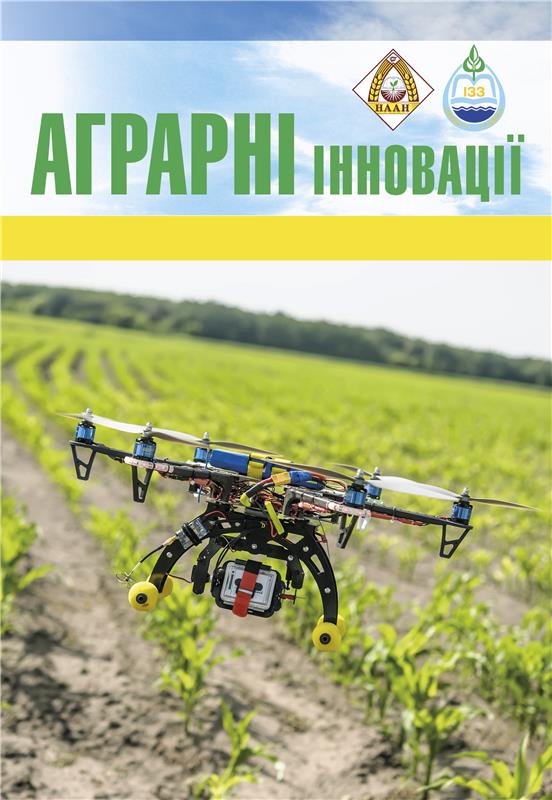PHOTOSYNTHETIC APPARATUS ACTIVITY AND PRODUCTIVITY OF WINTER TRITICALE UNDER TREATMENT WITH DR GRIN TECHNOLOGY
Abstract
The purpose of the research was to study the effect of mineral fertilizers, including microfertilizers, on the formation of leaf area when grown on gray forest soils of the Right-Bank Forest-Steppe of Ukraine. Materials and methods of research. In the experiments, winter triticale varieties Bogodarske and Bozhych were sown. The seeding rate of triticale in single-species crops was 4.0 million/haof germinating seeds. Mineral fertilizers were applied in the fall in the pre-sowing cultivation in the form of Polifoska 8 – N20 kg/ha d.p. (with a ratio of elements N8P24K24S9). Seeds were treated with Dr Green PRIME microfertilizer before sowing. In the spring, after the vegetation recovery, fertilizing with Saletrosan 26 + N90 (N26S32.5) mineral fertilizer was carried out. Foliar fertilization of plants in the following sequence: Dr Green Start+Dr Green Cereals – BBCH code 30 (beginning of the tube); Dr Green Energy+Dr Green Cereals – BBCH code 37 (tube); Dr Green Quality+Dr Green Cereals – BBCH code 59 (before flowering). The scheme of the experiment included: control (no fertilizers); N52S65 (background) – spring fertilization; N12P36K36S13.5 + Background; Background + seed treatment; Background + seed treatment + first fertilization; Background + seed treatment + two fertilizations; Background + seed treatment + three fertilizations. Research results. The treatment of plants with the microelement complex DR GRIN had a positive effect on the leaf index of both varieties of winter triticale in certain phases of vegetation. Under the influence of treatments, the weight of dry matter of the aerial part of plants per unit area of sowing increased in the phase of flag leaf and milk-wax ripeness, net productivity of photosynthesis during the period of flag leaf and milk-wax ripeness of grain, activity of antioxidant enzymes of chloroplasts compared to the corresponding indicators of plants of control variants. The increase in daily biomass production per unit of leaf surface of the crop confirmed that the treatment of winter triticale plants with DR GRIN microfertilizer contributed to the increase in the activity of their photosynthetic apparatus. It was proved that the increase in grain productivity was due to the optimization of the assimilation surface area at the beginning of the reproductive period and the higher activity of the photosynthetic apparatus of winter triticale during grain filling. As a result of the research, it was noted that the leaf area of winter triticale of Bozhych and Bogodarske varieties in the plots with mineral nutrition (N90) was at the level of 15.75%. The best indicators of winter triticale foliage were noted in the plots (Background + seed treatment + 2 fertilizers) of Bozhych variety – 19.83%, and Bogodarske variety in the plots (Background + seed treatment + 3 fertilizers) – 18.95%. In the winter triticale variety Bogodarske, an increase in the leaf area of plants with the second or third fertilization by 10.33 m2/ha was noted, respectively, to 41.44-44.56 m2/ha. In the variety Bozhych, at the second or third fertilization, the leaf area was 3.42 m2/ha higher than in the background (N90), but almost the same and amounted to 50.09-49.48 m2/ha.Conclusions. It was found that on gray forest soils mineral fertilizers and micronutrient fertilizers had a positive effect on the formation of foliage and leaf area of winter triticale. The largest leaf surface area (29.42 thousand m2/ha) was formed in the flag leaf phase when using mineral nutrition (P36K36+N90) did not significantly increase the leaf area in the Bozhych variety by 1.2% compared to the background.But in Bogodarske variety there was a significant increase in leaf area by 14% compared to the background, which indicates that the variety is more intensive. Two foliar treatments using DR GRIN technology in Bozhych increased the leaf area by 7.3%, and in Bogodarske by 21% compared to the background. The third foliar treatment in the Bozhych variety was 6% higher than in the background, but in the Bogodarske variety the increase in leaf area was 30% higher than in the background.
References
2. Habtamu A., Tadele T. K., Twain J. B., XueFeng M. Triticale Improvement for Forage and Cover Crop Uses in the Southern Great Plains of the United States. Front Plant Sci. 2018. № 9. Р. 1130. DOI : 10.3389/ fpls.2018.01130
3. Левченко О. С., Голик Л. М., Штакал М. І., Березовський О. В. Створення сортів тритикале озимого різного цільового призначення. Вісник аграрної науки. 2023. № 12 (849). С. 58–63. DOI: https://doi. org/10.31073/agrovisnyk202312-08
4. Савчук О. І., Мельничук А. О., Дребот О. В. Вплив системи удобрення на продуктивність тритикале озимого (Тriticosecale witt.) в умовах осушуваного дерново-підзолистого ґрунту Полісся. Зернові культури. Том 6. № 1. 2022. С. 116–123. DOI: https://doi. org/10.31867/2523-4544/0214
5. Волощук О. П., Волощук І. С., Глива В. В., Ковальчук О. І. Сортові ресурси, як фактор збільшення об’ємів виробництва високоякісного насіння тритикале озимого. Збалансоване природокористування. 2017. № 4. С. 53–58.
6. Пірич А. В., Федоренко М. В., Федоренко І. В., Кузьменко Є. А., Близнюк Р. М. Адаптивний потенціал селекційних ліній тритикале озимого (×Triticosecale Wittmack) в умовах Лісостепу України. Зернові культури. 2023. Том 7. № 1 С. 28–36. DOI: https://doi. org/10.31867/2523-4544/0255
7. Єгупова Т. В., Романюк П. В. Сучасні технології вирощування тритикале озимого в Правобережному Лісостепу. Вісник аграрної науки. 2020. № 7 (808). С. 31–37. DOI: https://doi.org/10.31073/agrovisnyk 202007-04.
8. Юла В. М. Адаптивні технології вирощування зернових культур в Лісостепу. Адаптивні системи землеробства і сучасні агротехнології – основа раціонального землекористування, збереження і відтворення родючості ґрунтів; за ред. В. Ф. Камінського. Київ: ВП «Едельвейс», 2013. С. 255–267.
9. Hyrka, A. D., Tkalich, I. D., Sydorenko, Yu. Ya., Bochevar, O. V., Ilienko, O. V., & Mamiedova, E. I. The spring barley yield and grain quality formation in dependence of growth regulators and fertilizers use. Grain Crops. 2017. 1(1). С. 59–65.
10. Ювчик Н. О. Фотосинтетична діяльність пшениці озимої залежно від удобрення та вапнування на дерново-підзолистому ґрунті в умовах Західного Полісся. Зернові культури. Том 7. № 1. 2023. С. 184–189. DOI: https://doi.org/10.31867/2523-4544/0275
11. Білітюк А. П. Ріст і розвиток рослин тритикале залежно від впливумінеральних добрив. Вісник аграрних науки. 2002. № 8. С. 23–27.
12. Свідерко М. Є., Шувар А. М., Беген Л. Л. Ефективність позакореневого підживлення тритикале озимого. Агротехнічні основи підвищення ефективності виробництва зерна тритикале у різних зонах України : матеріали наук.-прак. конф., 16–17 черв. 2010 р. Рокині : 2010. С. 119–124.
13. Карпенко В. П., Притуляк Р. М., Чернега А. О. Вміст білка і клейковини у зерні тритикале озимого за використання біологічно активних речовин. Збірник наукових праць Уманського національного університету садівництва. 2013. Вип. 82. С. 14–18.
14. Адамень Ф. Ф., Радченко Л. А, Женченко К. Г. Особливості фотосинтетичної діяльності рослин пшениці різних біотипів. Вісник аграрної науки. № 6. (698). 2011. С. 16–20.
15. Шейко Д.В. Фотосинтетичний потенціал сортів пшениці озимої залежно від способів застосування біологічно активних препаратів в умовах Західного Лісостепу. Аграрні інновації. 2023. № 19. С. 115-119. DOI: https://doi.org/10.32848/agrar.innov.2023.19.18
16. Солодушко М. М., Безсусідня Ю. В. Фотосинтетична діяльність рослин жита озимого (Secale cereale L.) залежно від умов вирощування в Північному Степу України. Зернові культури. 2023. Том 7. № 1. С. 138-145. DOI: https://doi. org/10.31867/2523-4544/0269






